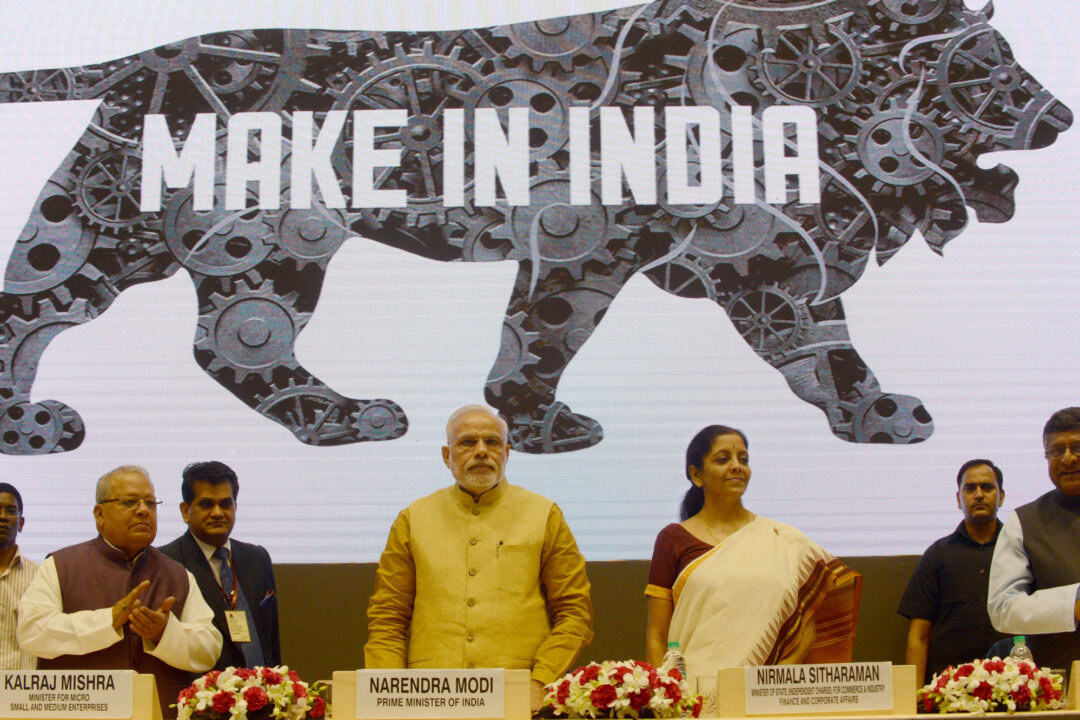New Delhi’s initiative aims to minimize potential disruption in the supply chain for a growing domestic market and boost national security.
NEW DELHI—India is offering billions of dollars of incentives to its electronics industry with an intent to cut reliance on China and boost national security, according to an expert from an Indian government-backed think tank.
“It is happening across the spectrum as part of [a] production-linked incentive,” Pathikrit Payne, a senior fellow with the Dr. Syama Prasad Mookerjee Research Foundation, a think tank affiliated with India’s ruling Bharatiya Janata Party, told The Epoch Times.
“It is working pretty well, progressing in the right direction. As part of it, electronics are being added to it.”
India’s push for in-house manufacturing gained fresh momentum when New Delhi launched the Atmanir Bhar Bharat, or Self-Reliant India campaign, during the COVID-19 pandemic in May 2020. The initiative’s main objective is to decrease reliance on imports by enhancing domestic production. The government introduced its first phase of the incentive program in 2021, followed by another this year.
According to Payne, 15 sectors are included in this 2024 government initiative to incentivize manufacturing in India. This marks the two phases of support for electronics manufacturing. The 2021 phase focused primarily on printed circuit boards and mobile phones, among other things. The current phase targets semiconductors, laptop production, and the development of domestic supply chains.
New Delhi’s initiative aims to encourage the domestic market to reduce its reliance on imports, as experts say India has the capacity to start manufacturing locally.
Payne gave examples of how mobile phones are already being manufactured in the Indian market, whereas the laptop market continues to depend on massive imports despite the capacity to self-manufacture.
India has emerged as the second-largest manufacturer of mobile phones in the world, while China remains the largest, according to official data. Various market studies report a burgeoning laptop market in India, driven by a significant increase in demand for affordable devices among a population that is becoming increasingly tech-savvy.
A Stellar Market Research report revealed that India’s laptop market size was estimated at $6.9 billion in 2023; total laptop revenue is expected to grow at a compound annual growth rate of 4.5 percent from 2024 to 2030, reaching nearly $9.39 billion in 2030.
“India now has the bandwidth to manufacture [laptops],“ Payne said. ”It is just that the companies had taken it for granted because they thought they could import into India forever.”
The Indian government is encouraging local laptop manufacturers through a combination of policies, such as providing incentives for local manufacturing and increasing laptop import duties.
“So invariably, if we are such a big market for laptops, and we have such tech proficiency in terms of manpower, there is no reason why we cannot make it on our own, and there is no reason why companies [that] are importing those laptops cannot make it in India,” he said.
By implementing policies that promote the production of laptops and other electronics in India, New Delhi is sending a clear message to manufacturers, according to Payne: If you want to access the Indian market, you “invariably have to think about making them in India.”Payne noted that the global geopolitical situation is becoming increasingly uncertain and that this is particularly concerning for fast-growing economies like India. Global supply chains are interconnected across nations and sectors, he said, and they are increasingly being utilized in geopolitical competition and warfare.
“The issue is not just about dependence on Chinese components, which is invariably pretty high, but even if you are taking it from other areas—whether it is from Korea or Taiwan or elsewhere—given the geopolitical situation right now globally, you can have conflicts coming up, anytime, anywhere,” he said.
“Whatever happens, whether it is in the South China Sea or in the Korean Peninsula or in the Taiwan Strait or elsewhere, it invariably will end up creating disruptions in the supply chain.”
The Indian manufacturing sector and the broader economy are facing significant geopolitical challenges, one of which is the threat to national security posed by the Chinese regime’s access to information from mobile phones and laptops manufactured in China. Payne said the Indian government is highly aware of this issue and is eager to promote made-in-India products to counter the Chinese regime.
“Electronics do have a huge impact—so far as national security is concerned—both electronics and software,” the expert said.
After the June 2020 bloody Galwan border conflict between India and China, New Delhi took numerous punitive measures, such as banning hundreds of Chinese apps, including TikTok, in the Indian market. According to Payne, this didn’t help resolve the Chinese theft of Indian intellectual property.
“It is important to understand that there’s something called a back door,“ he said. ”Back door is hardware-based or unauthorized passing of information—that is something which happens all the time.”
The top priority of the Self-Reliant India campaign is to manufacture products in India, create jobs, and establish local supply chains, the expert said.
India has made significant investments in its initiative, focusing on various sectors. Payne said that moving forward, New Delhi aims to ensure that a substantial portion of the supply chains for critical electronic components and the electronic manufacturing ecosystem remain rooted in India.
“There is invariably the issue of national security because of two things: the sanctity of the components and the products and No. 2, to ensure that there is no disruption in the supply chain—both are critical,” the expert said.

